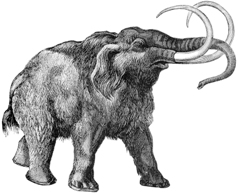 Geologist and science writer Nina Morgan samples some festive geological fare
Geologist and science writer Nina Morgan samples some festive geological fare
For palaeontologists what could be more enticing than a festive meal featuring tasty samples of extinct animals? Of the recently departed, the dodo (Raphus cucullatus) might have been one possibility. But alas, the last documented sighting of a living dodo was in the 17th Century, and no one thought to pop the bird into a freezer for later consumption.
Woolly mammoths (Mammuthus primigenius), however, are a different kettle of fish. These extinct relatives of today's elephants flourished during the Pleistocene ice ages, around 250,000 – 4000 years ago. The first fully documented discovery of a mammoth fossil was recorded in 1799 by a hunter who came across frozen remains in permafrost along a riverbank in Siberia. Since then significant finds of frozen and mummified carcasses of woolly mammoths have been recorded from more than 100 sites in North America and Eurasia. As a result of their often rapid ‘fossilisation’, much is known about the diet and demise of individual animals.
Fresh-frozen fossils
In his book, Siberian Man and Mammoth, E W Pfitzenmayer, a scientist who undertook expeditions to Siberia in 1901 and 1908, describes the thrill of finding and excavating the body of a woolly mammoth from its 'icy grave':
“... we found half-chewed food still in its mouth, between the back teeth and on its tongue, which was in good preservation. The food consisted of leaves and grasses, some of the latter carrying seeds. We could tell from these that the mammoth must have come to its miserable end in the autumn.” This form of rapid fresh-frozen fossilisation also provided Pfitzenmayer with a unique opportunity to sample and describe mammoth meat:
"The well-preserved flesh on the upper parts of the foreleg and thigh and on the pelvis was streaked with thick layers of fat. As long as it was frozen it had a quite fresh and healthy appearance, and a dark-red colour like that of frozen reindeer or horseflesh, but was considerably coarser in fibre."
Dining dangerously
It may have been accounts such as Pfitzenmayer's that inspired the members of the Explorers Club, an American-based international multidisciplinary professional society founded in 1905 to promote scientific exploration and field study, to put mammoth on the menu for its annual dinner in 1951. These annual dinners, held to honour accomplishments in exploration and hosted at the club's headquarters in New York City, are famous for their menus based on adventurous and exotic cuisine, including delicacies such as fried tarantulas and goat eyeballs.
However, right from the start, doubts as to the identity of the exotic meat served up in 1951 began to arise. In fact, the meat, said to be sourced from Alaska, was originally billed on the menu as Megatherium, an extinct ground sloth known only from South America. If true, that in itself would have been remarkable, because it would have extended the species' known range to as far north as the Aleutian Islands in Alaska.
But as it turned out the meat served up was neither mammoth nor Megatherium. Its true identity was revealed in 2015 when scientists at Yale University in Connecticut, US carried out DNA analysis on a preserved sample of the cooked flesh. The diagnosis? Chelonia mydas, or green sea turtle, perhaps a leftover from the turtle soup that was also on the menu that night.
A disappointing result for palaeontologists perhaps, but for the diners, it turned out to be a lucky escape. Pfitzenmayer recalled that as soon as the mammoth meat thawed, it entirely changed its appearance, and "... became flabby and grey and gave off a repulsive ammoniaical stench that pervaded everything.”
Give me turkey any day! A very happy festive season to all.
Acknowledgements
Sources for this vignette include: the article The Explorers Club Once Served Mammoth at a Meal. Or Did It? published on 3 February 2016 and available at: www.nytimes.com/2016/02/04/science/explorers-club-mammoth-dinner.html;
Glass JR et al. (2016) Was Frozen Mammoth or Giant Ground Sloth Served for Dinner at The Explorers Club? PLoS ONE 11(2): available for download at: http://journals.plos.org/plosone/article?id=10.1371/journal.pone.0146825; Siberian Man and Mammoth by E W Pfitzenmayer, Blackie & Son Ltd, 1939; the entry for mammoths at http://www.newworldencyclopedia.org/entry/Woolly_mammoth; and the Wikipedia entry for The Explorers Club.
* Nina Morgan is a geologist and science writer based near Oxford. Her latest book, The Geology of Oxford Gravestones, is available via www.gravestonegeology.uk